2015 MERCEDES-BENZ GLE SUV snow chains
[x] Cancel search: snow chainsPage 12 of 453
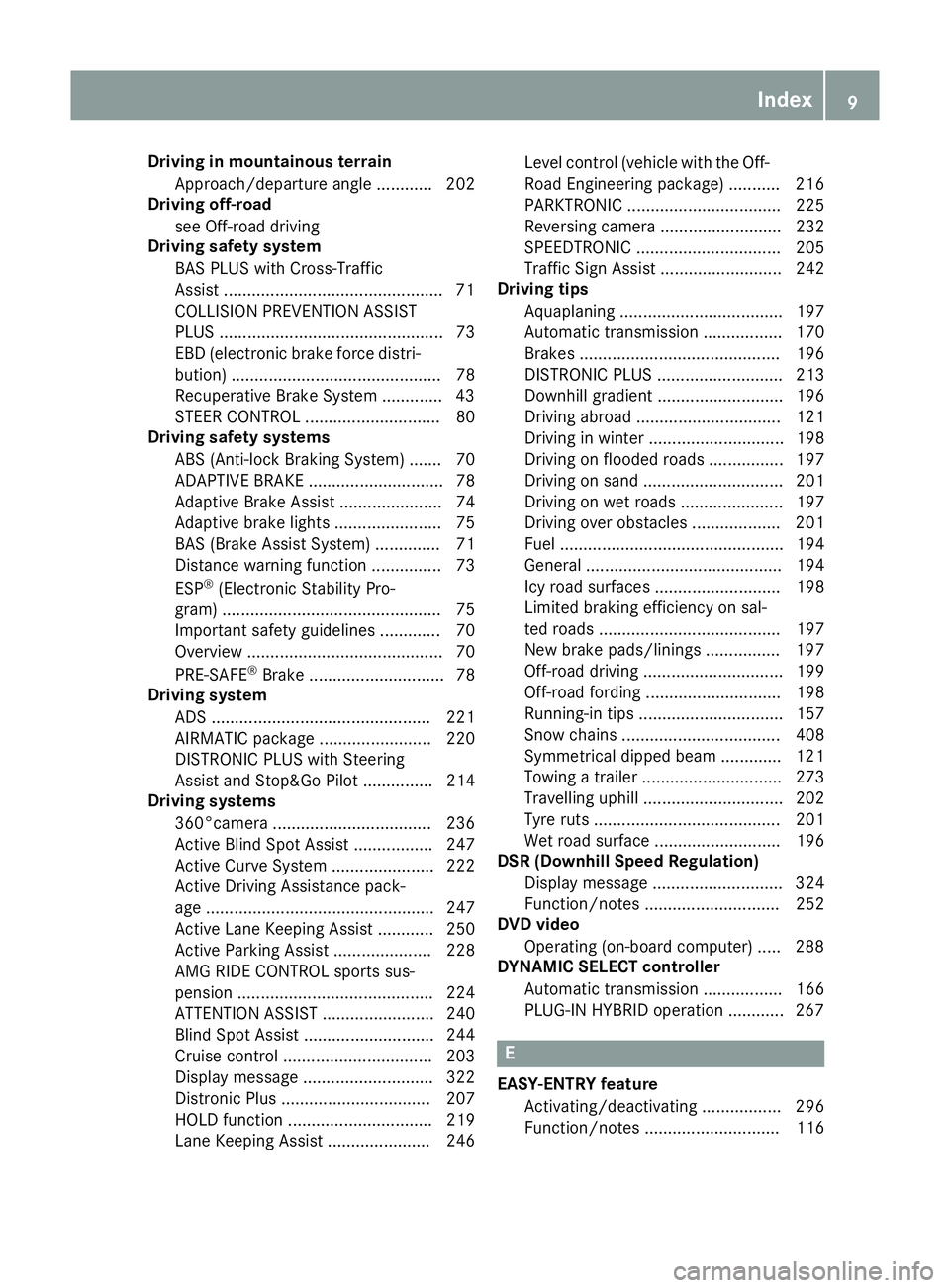
Driving in mountainous terrain
Approach/departure angle ............ 202
Driving off-road
see Off-road driving
Driving safety system
BAS PLUS with Cross-Traffic
Assist .............................................. .71
COLLISION PREVENTION ASSIST
PLUS ................................................ 73
EBD (electronic brake force distri- bution ) ............................................. 78
Recuperative Brake Syste m .............43
STEER CONTROL ............................. 80
Driving safety systems
ABS (Anti-lock Braking System) ....... 70
ADAPTIVE BRAK E............................. 78
Adaptive Brake Assist ...................... 74
Adaptive brake lights ....................... 75
BAS (Brake Assist System) .............. 71
Distance warning function ............... 73
ESP ®
(Electronic Stability Pro-
gram) ............................................... 75
Important safety guidelines ............. 70
Overview .......................................... 70
PRE-SAFE ®
Brake ............................. 78
Driving system
ADS ............................................... 221
AIRMATIC package ........................ 220
DISTRONIC PLUS with Steering
Assist and Stop&Go Pilot ............... 214
Driving systems
360°camera .................................. 236
Active Blind Spot Assist ................. 247
Active Curve System ...................... 222
Active Driving Assistance pack-
age ................................................. 247
Active Lane Keeping Assist ............ 250
Active Parking Assist ..................... 228
AMG RIDE CONTROL sports sus-
pension .......................................... 224
ATTENTION ASSIST ........................ 240
Blind Spot Assist ............................ 244
Cruise control ................................ 203
Display message ............................ 322
Distronic Plus ................................ 207
HOLD function ............................... 219
Lane Keeping Assist ...................... 246 Level control (vehicle with the Off-
Road Engineering package) ........... 216
PARKTRONIC ................................. 225
Reversing camera .......................... 232
SPEEDTRONIC ............................... 205
Traffic Sign Assist .......................... 242
Driving tips
Aquaplaning ................................... 197
Automatic transmission ................. 170
Brakes ........................................... 196
DISTRONIC PLUS ........................... 213
Downhill gradient ........................... 196
Driving abroad ............................... 121
Driving in winter ............................. 198
Driving on flooded roads ................ 197
Driving on sand .............................. 201
Driving on wet roads ...................... 197
Driving over obstacles ................... 201
Fuel ................................................ 194
General .......................................... 194
Icy road surfaces ........................... 198
Limited braking efficiency on sal-
ted roads ....................................... 197
New brake pads/linings ................ 197
Off-road driving .............................. 199
Off-road fording ............................. 198
Running-in tip s............................... 157
Snow chains .................................. 408
Symmetrical dipped beam ............. 121
Towing a trailer .............................. 273
Travelling uphill .............................. 202
Tyre ruts ........................................ 201
Wet road surface ........................... 196
DSR (Downhill Speed Regulation)
Display message ............................ 324
Function/note s............................. 252
DVD video
Operating (on-board computer) ..... 288
DYNAMIC SELECT controller
Automatic transmission ................. 166
PLUG-IN HYBRID operation ............ 267 E
EASY-ENTRY feature Activating/deactivating ................. 296
Function/note s............................. 116 Index
9
Page 23 of 453
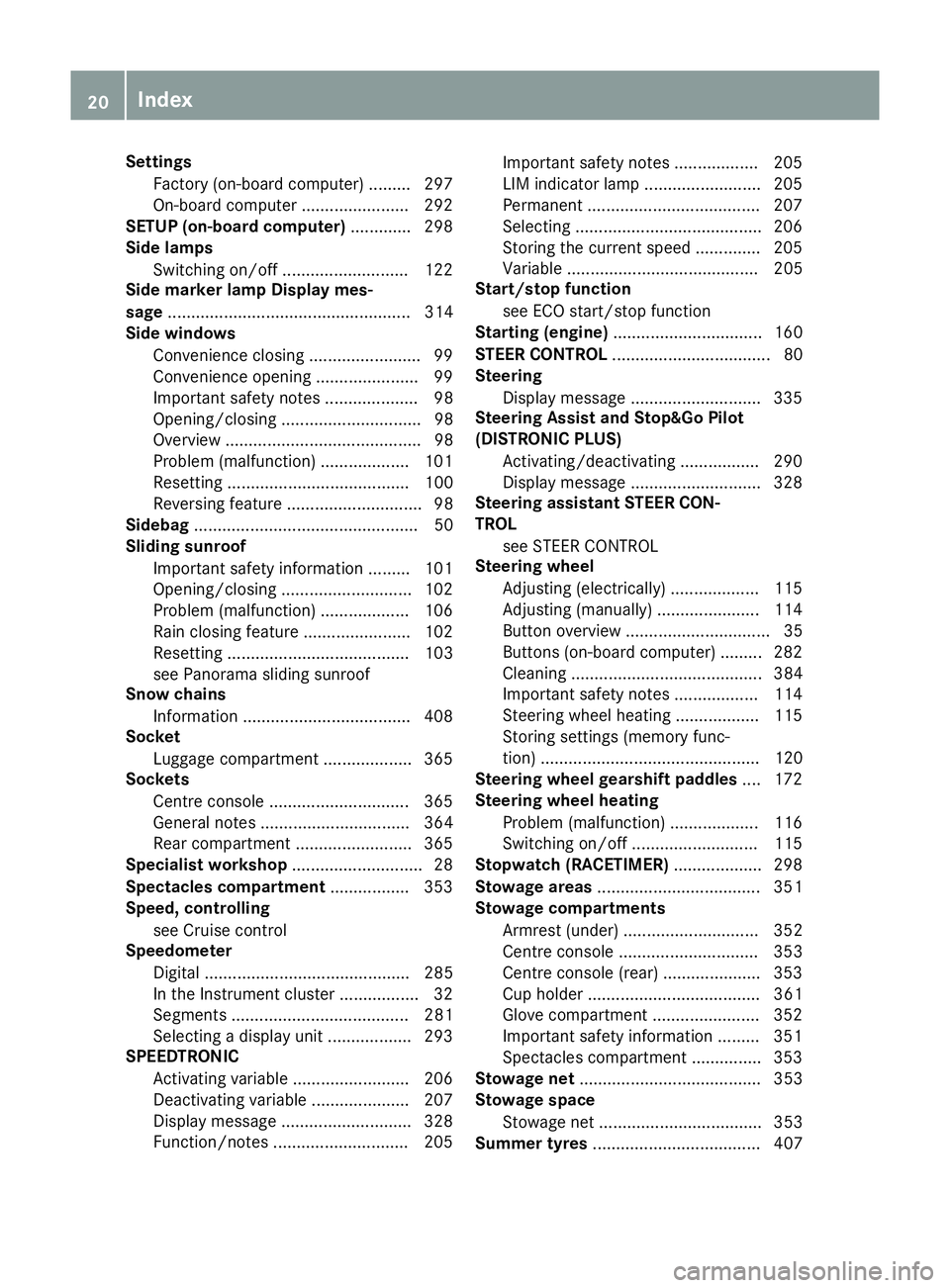
Settings
Factory (on-board computer) ......... 297
On-board computer ....................... 292
SETUP (on-board computer) .............298
Side lamps
Switching on/off ........................... 122
Side marker lamp Display mes-
sage .................................................... 314
Side windows
Convenience closing ........................ 99
Convenience opening ..................... .99
Important safety notes .................... 98
Opening/closing .............................. 98
Overview .......................................... 98
Problem (malfunction) ................... 101
Resetting ....................................... 100
Reversing feature .............................98
Sidebag ................................................ 50
Sliding sunroof
Important safety information ......... 101
Opening/closing ............................1 02
Problem (malfunction) ................... 106
Rain closing feature ....................... 102
Resetting ....................................... 103
see Panorama sliding sunroof
Snow chains
Information ................................... .408
Socket
Luggage compartment ................... 365
Sockets
Centre console .............................. 365
General notes ................................ 364
Rear compartment ......................... 365
Specialist workshop ............................ 28
Spectacles compartment ................. 353
Speed, controlling
see Cruise control
Speedometer
Digital ............................................ 285
In the Instrument cluster ................. 32
Segments ...................................... 281
Selecting a display unit .................. 293
SPEEDTRONIC
Activating variable ......................... 206
Deactivating variable ..................... 207
Display message ............................ 328
Function/notes ............................ .205 Important safety notes .................. 205
LIM indicator lamp ......................... 205
Permanent ..................................... 207
Selecting ........................................ 206
Storing the current spee d.............. 205
Variabl e......................................... 205
Start/stop function
see ECO start/stop function
Starting (engine) ................................ 160
STEER CONTROL .................................. 80
Steering
Display message ............................ 335
Steering Assist and Stop&Go Pilot
(DISTRONIC PLUS)
Activating/deactivating ................. 290
Display message ............................ 328
Steering assistant STEER CON-
TROL
see STEER CONTROL
Steering wheel
Adjusting (electrically) ................... 115
Adjusting (manually) ...................... 114
Button overview ............................... 35
Buttons (on-board computer) ......... 282
Cleaning ......................................... 384
Important safety notes .................. 114
Steering wheel heating .................. 115
Storing settings (memory func-
tion) ............................................... 120
Steering wheel gearshift paddles .... 172
Steering wheel heating
Problem (malfunction) ................... 116
Switching on/of f........................... 115
Stopwatch (RACETIMER) ................... 298
Stowage areas ................................... 351
Stowage compartments
Armrest (under) ............................. 352
Centre console .............................. 353
Centre console (rear) ..................... 353
Cup holde r..................................... 361
Glove compartment ....................... 352
Important safety information ......... 351
Spectacles compartment ............... 353
Stowage net ....................................... 353
Stowage space
Stowage net ................................... 353
Summer tyres .................................... 40720
Index
Page 27 of 453
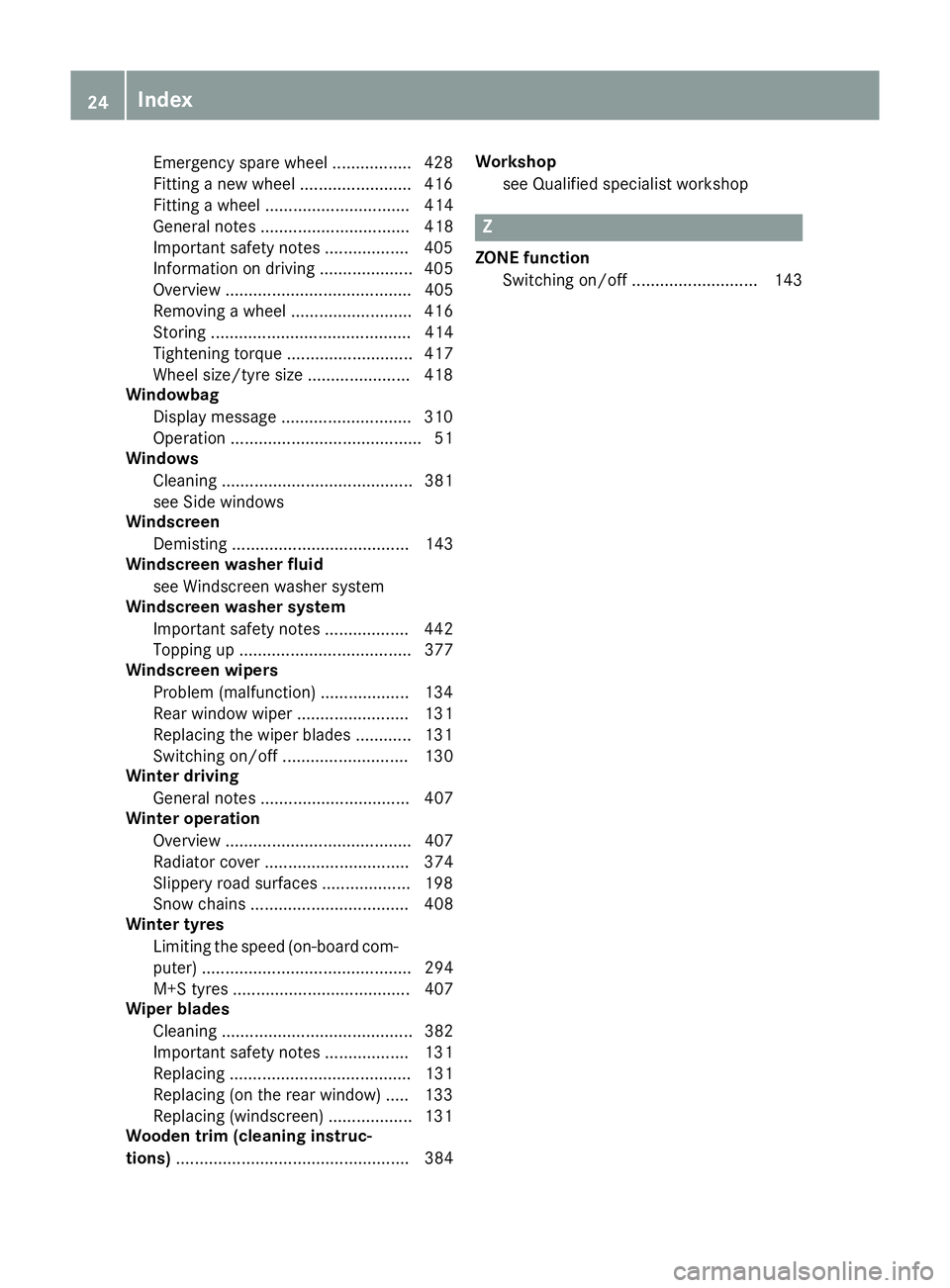
Emergency spare wheel ................. 428
Fitting a new wheel ........................ 416
Fitting a wheel ............................... 414
General notes ................................ 418
Important safety note s.................. 405
Information on driving .................... 405
Overview ........................................ 405
Removing a whee l.......................... 416
Storing ........................................... 414
Tightening torque ........................... 417
Wheel size/tyre size ...................... 418
Windowbag
Display message ............................ 310
Operation ......................................... 51
Windows
Cleaning ......................................... 381
see Side windows
Windscreen
Demisting ...................................... 143
Windscreen washer fluid
see Windscreen washer system
Windscreen washer system
Important safety notes .................. 442
Topping up ..................................... 377
Windscreen wipers
Problem (malfunction) ................... 134
Rear window wipe r........................ 131
Replacing the wiper blades ............ 131
Switching on/of f........................... 130
Winter driving
General notes ................................ 407
Winter operation
Overview ........................................ 407
Radiator cover ............................... 374
Slippery road surfaces ................... 198
Snow chains .................................. 408
Winter tyres
Limiting the speed (on-board com-
puter) ............................................. 294
M+S tyres ...................................... 407
Wiper blades
Cleaning ......................................... 382
Important safety notes .................. 131
Replacing ....................................... 131
Replacing (on the rear window )..... 133
Replacing (windscreen) .................. 131
Wooden trim (cleaning instruc-
tions) .................................................. 384 Workshop
see Qualified specialist workshop Z
ZONE function Switching on/of f........................... 143 24
Index
Page 73 of 453
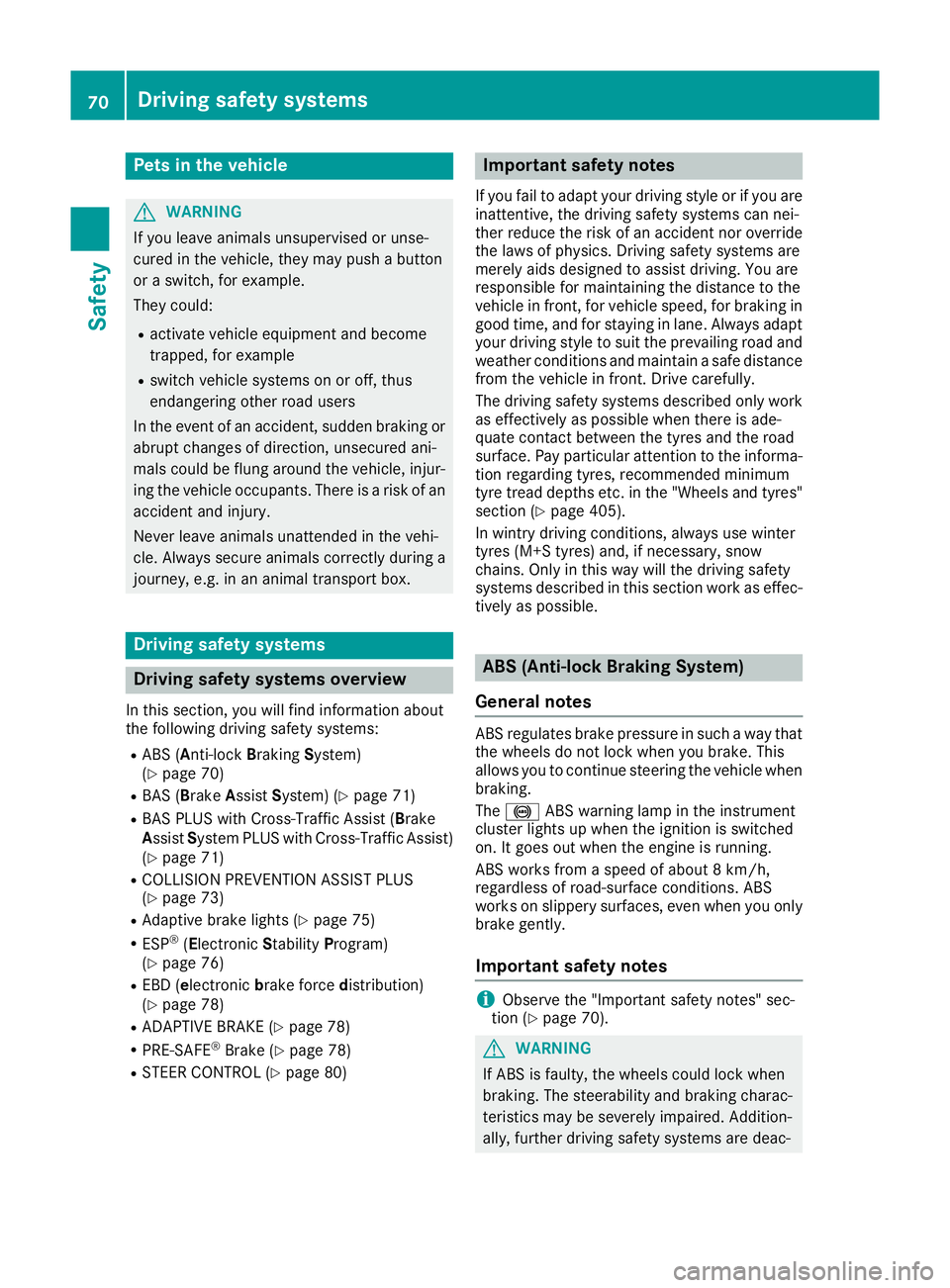
Pets in the vehicle
G
WARNING
If you leave animals unsupervised or unse-
cured in the vehicle, they may push a button
or a switch, for example.
They could:
R activate vehicle equipment and become
trapped, for example
R switch vehicle systems on or off, thus
endangering other road users
In the event of an accident, sudden braking or
abrupt changes of direction, unsecured ani-
mals could be flung around the vehicle, injur-
ing the vehicle occupants. There is a risk of an accident and injury.
Never leave animals unattended in the vehi-
cle. Always secure animals correctly during a
journey, e.g. in an animal transport box. Driving safety systems
Driving safety systems overview
In this section, you will find information about
the following driving safety systems:
R ABS (Anti-lock BrakingSystem)
(Y page 70)
R BAS ( Brake Assist System) (Y page 71)
R BAS PLUS with Cross-Traffic Assist ( Brake
Assist System PLUS with Cross-Traffic Assist)
(Y page 71)
R COLLISION PREVENTION ASSIST PLUS
(Y page 73)
R Adaptive brake lights (Y page 75)
R ESP ®
(Electronic StabilityProgram)
(Y page 76)
R EBD ( electronic brake force distribution)
(Y page 78)
R ADAPTIVE BRAKE (Y page 78)
R PRE-SAFE ®
Brake (Y page 78)
R STEER CONTROL (Y page 80) Important safety notes
If you fail to adapt your driving style or if you are
inattentive, the driving safety systems can nei-
ther reduce the risk of an accident nor override the laws of physics. Driving safety systems are
merely aids designed to assist driving. You are
responsible for maintaining the distance to the
vehicle in front, for vehicle speed, for braking in
good time, and for staying in lane. Always adapt your driving style to suit the prevailing road and
weather conditions and maintain a safe distance from the vehicle in front. Drive carefully.
The driving safety systems described only work
as effectively as possible when there is ade-
quate contact between the tyres and the road
surface. Pay particular attention to the informa- tion regarding tyres, recommended minimum
tyre tread depths etc. in the "Wheels and tyres" section (Y page 405).
In wintry driving conditions, always use winter
tyres (M+S tyres) and, if necessary, snow
chains. Only in this way will the driving safety
systems described in this section work as effec-
tively as possible. ABS (Anti-lock Braking System)
General notes ABS regulates brake pressure in such a way that
the wheels do not lock when you brake. This
allows you to continue steering the vehicle when braking.
The ! ABS warning lamp in the instrument
cluster lights up when the ignition is switched
on. It goes out when the engine is running.
ABS works from a speed of about 8 km/h,
regardless of road-surface conditions. ABS
works on slippery surfaces, even when you only brake gently.
Important safety notes i
Observe the "Important safety notes" sec-
tion (Y page 70). G
WARNING
If ABS is faulty, the wheels could lock when
braking. The steerability and braking charac-
teristics may be severely impaired. Addition-
ally, further driving safety systems are deac- 70
Driving safety systemsSafety
Page 80 of 453
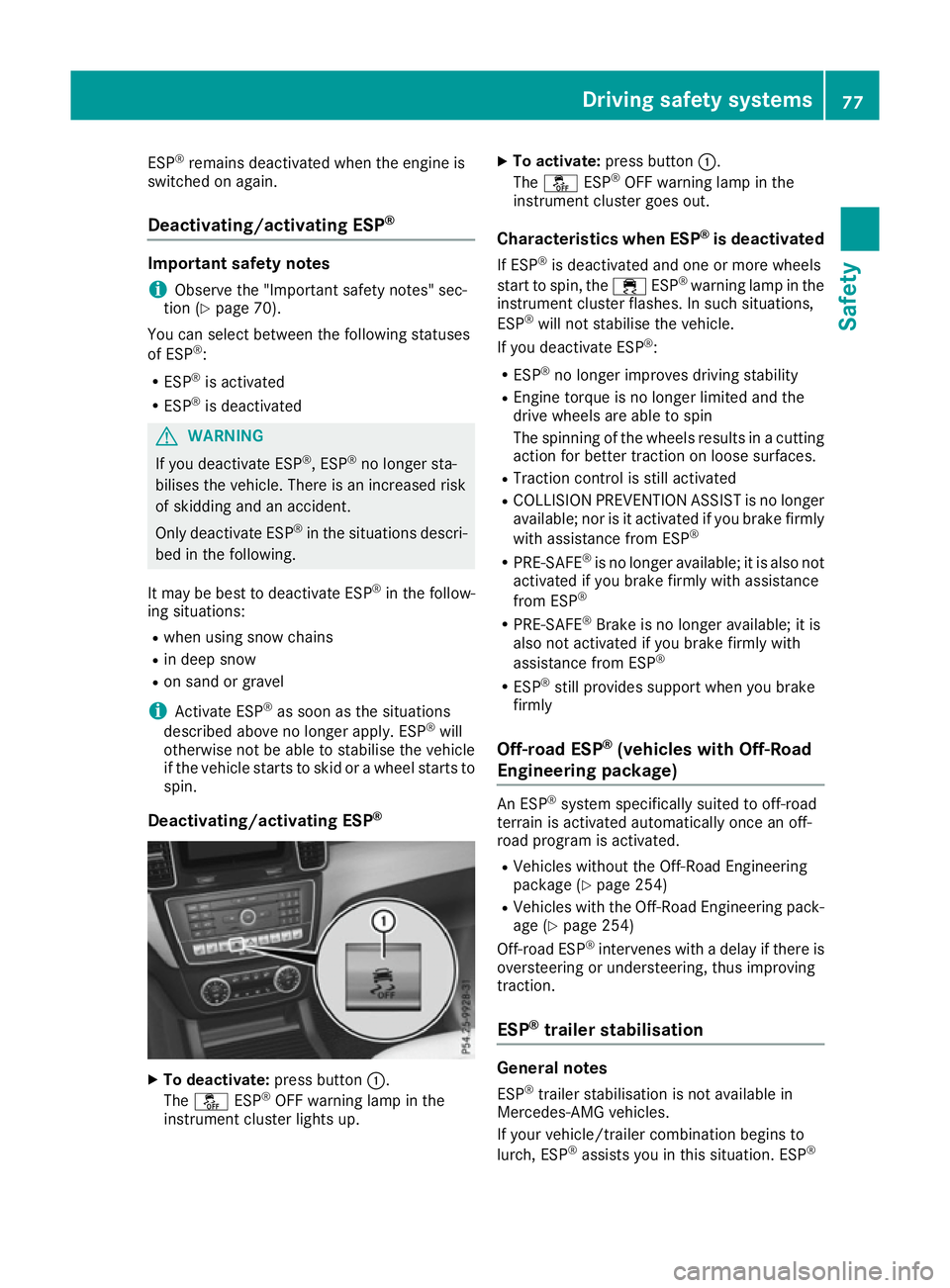
ESP
®
remains deactivated when the engine is
switched on again.
Deactivating/activating ESP ®Important safety notes
i Observe the "Important safety notes" sec-
tion (Y page 70).
You can select between the following statuses
of ESP ®
:
R ESP ®
is activated
R ESP ®
is deactivated G
WARNING
If you deactivate ESP ®
, ESP ®
no longer sta-
bilises the vehicle. There is an increased risk
of skidding and an accident.
Only deactivate ESP ®
in the situations descri-
bed in the following.
It may be best to deactivate ESP ®
in the follow-
ing situations:
R when using snow chains
R in deep snow
R on sand or gravel
i Activate ESP ®
as soon as the situations
described above no longer apply. ESP ®
will
otherwise not be able to stabilise the vehicle
if the vehicle starts to skid or a wheel starts to
spin.
Deactivating/activating ESP ®X
To deactivate: press button:.
The å ESP®
OFF warning lamp in the
instrument cluster lights up. X
To activate: press button :.
The å ESP®
OFF warning lamp in the
instrument cluster goes out.
Characteristics when ESP ®
is deactivated
If ESP ®
is deactivated and one or more wheels
start to spin, the ÷ESP®
warning lamp in the
instrument cluster flashes. In such situations,
ESP ®
will not stabilise the vehicle.
If you deactivate ESP ®
:
R ESP ®
no longer improves driving stability
R Engine torque is no longer limited and the
drive wheels are able to spin
The spinning of the wheels results in a cutting
action for better traction on loose surfaces.
R Traction control is still activated
R COLLISION PREVENTION ASSIST is no longer
available; nor is it activated if you brake firmly
with assistance from ESP ®
R PRE-SAFE ®
is no longer available; it is also not
activated if you brake firmly with assistance
from ESP ®
R PRE-SAFE ®
Brake is no longer available; it is
also not activated if you brake firmly with
assistance from ESP ®
R ESP ®
still provides support when you brake
firmly
Off-road ESP ®
(vehicles with Off-Road
Engineering package) An ESP
®
system specifically suited to off-road
terrain is activated automatically once an off-
road program is activated.
R Vehicles without the Off-Road Engineering
package (Y page 254)
R Vehicles with the Off-Road Engineering pack-
age (Y page 254)
Off-road ESP ®
intervenes with a delay if there is
oversteering or understeering, thus improving
traction.
ESP ®
trailer stabilisation General notes
ESP ®
trailer stabilisation is not available in
Mercedes-AMG vehicles.
If your vehicle/trailer combination begins to
lurch, ESP ®
assists you in this situation. ESP ® Driving safety systems
77Safety Z
Page 201 of 453
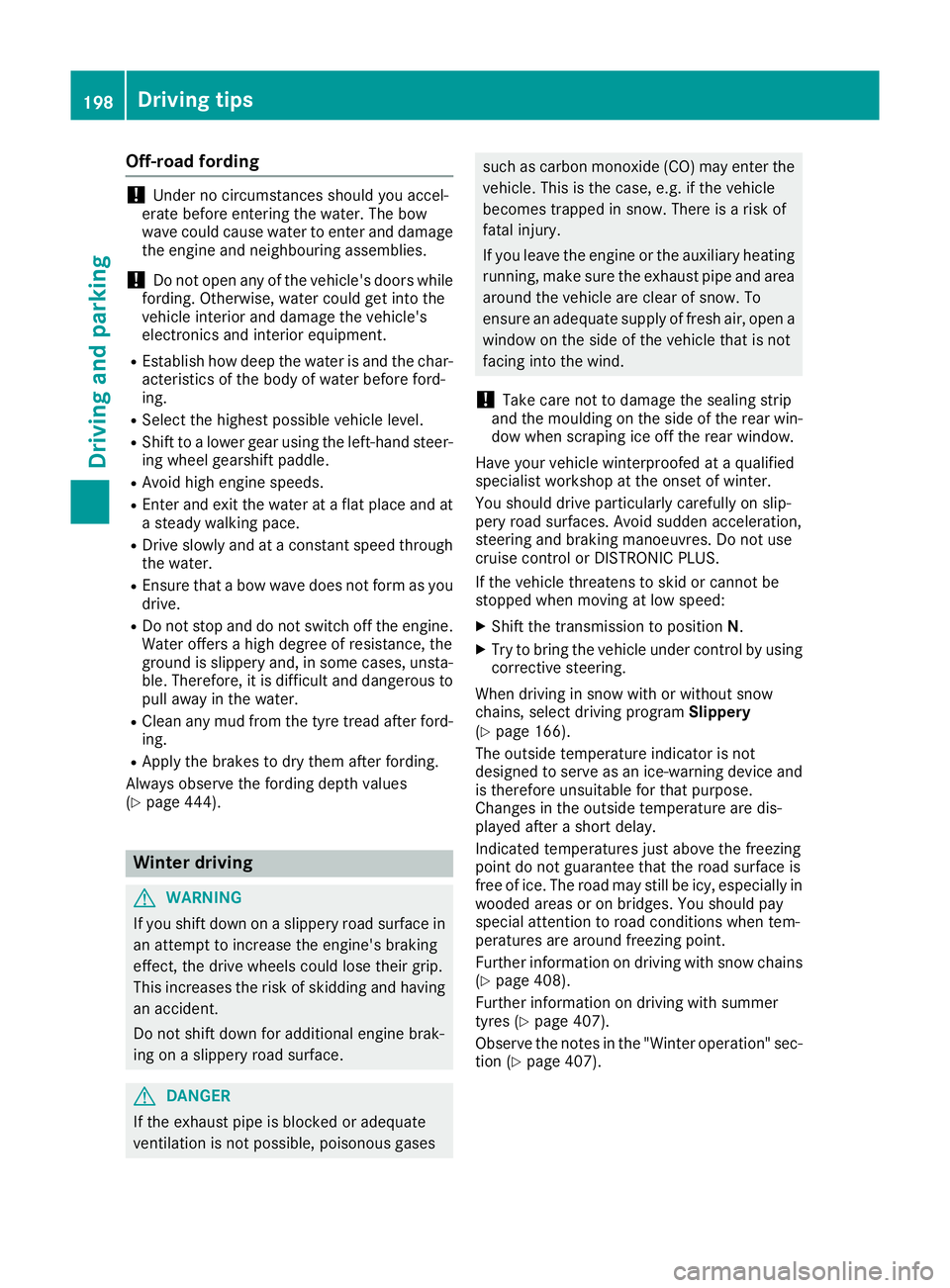
Off-road fording
!
Under no circumstances should you accel-
erate before entering the water. The bow
wave could cause water to enter and damage
the engine and neighbouring assemblies.
! Do not open any of the vehicle's doors while
fording. Otherwise, water could get into the
vehicle interior and damage the vehicle's
electronics and interior equipment.
R Establish how deep the water is and the char-
acteristics of the body of water before ford-
ing.
R Select the highest possible vehicle level.
R Shift to a lower gear using the left-hand steer-
ing wheel gearshift paddle.
R Avoid high engine speeds.
R Enter and exit the water at a flat place and at
a steady walking pace.
R Drive slowly and at a constant speed through
the water.
R Ensure that a bow wave does not form as you
drive.
R Do not stop and do not switch off the engine.
Water offers a high degree of resistance, the
ground is slippery and, in some cases, unsta- ble. Therefore, it is difficult and dangerous to
pull away in the water.
R Clean any mud from the tyre tread after ford-
ing.
R Apply the brakes to dry them after fording.
Always observe the fording depth values
(Y page 444). Winter driving
G
WARNING
If you shift down on a slippery road surface in an attempt to increase the engine's braking
effect, the drive wheels could lose their grip.
This increases the risk of skidding and having
an accident.
Do not shift down for additional engine brak-
ing on a slippery road surface. G
DANGER
If the exhaust pipe is blocked or adequate
ventilation is not possible, poisonous gases such as carbon monoxide (CO) may enter the
vehicle. This is the case, e.g. if the vehicle
becomes trapped in snow. There is a risk of
fatal injury.
If you leave the engine or the auxiliary heating
running, make sure the exhaust pipe and area
around the vehicle are clear of snow. To
ensure an adequate supply of fresh air, open a window on the side of the vehicle that is not
facing into the wind.
! Take care not to damage the sealing strip
and the moulding on the side of the rear win- dow when scraping ice off the rear window.
Have your vehicle winterproofed at a qualified
specialist workshop at the onset of winter.
You should drive particularly carefully on slip-
pery road surfaces. Avoid sudden acceleration,
steering and braking manoeuvres. Do not use
cruise control or DISTRONIC PLUS.
If the vehicle threatens to skid or cannot be
stopped when moving at low speed:
X Shift the transmission to position N.
X Try to bring the vehicle under control by using
corrective steering.
When driving in snow with or without snow
chains, select driving program Slippery
(Y page 166).
The outside temperature indicator is not
designed to serve as an ice-warning device and
is therefore unsuitable for that purpose.
Changes in the outside temperature are dis-
played after a short delay.
Indicated temperatures just above the freezing
point do not guarantee that the road surface is
free of ice. The road may still be icy, especially in wooded areas or on bridges. You should pay
special attention to road conditions when tem-
peratures are around freezing point.
Further information on driving with snow chains
(Y page 408).
Further information on driving with summer
tyres (Y page 407).
Observe the notes in the "Winter operation" sec-
tion (Y page 407). 198
Driving tipsDriving and parking
Page 226 of 453
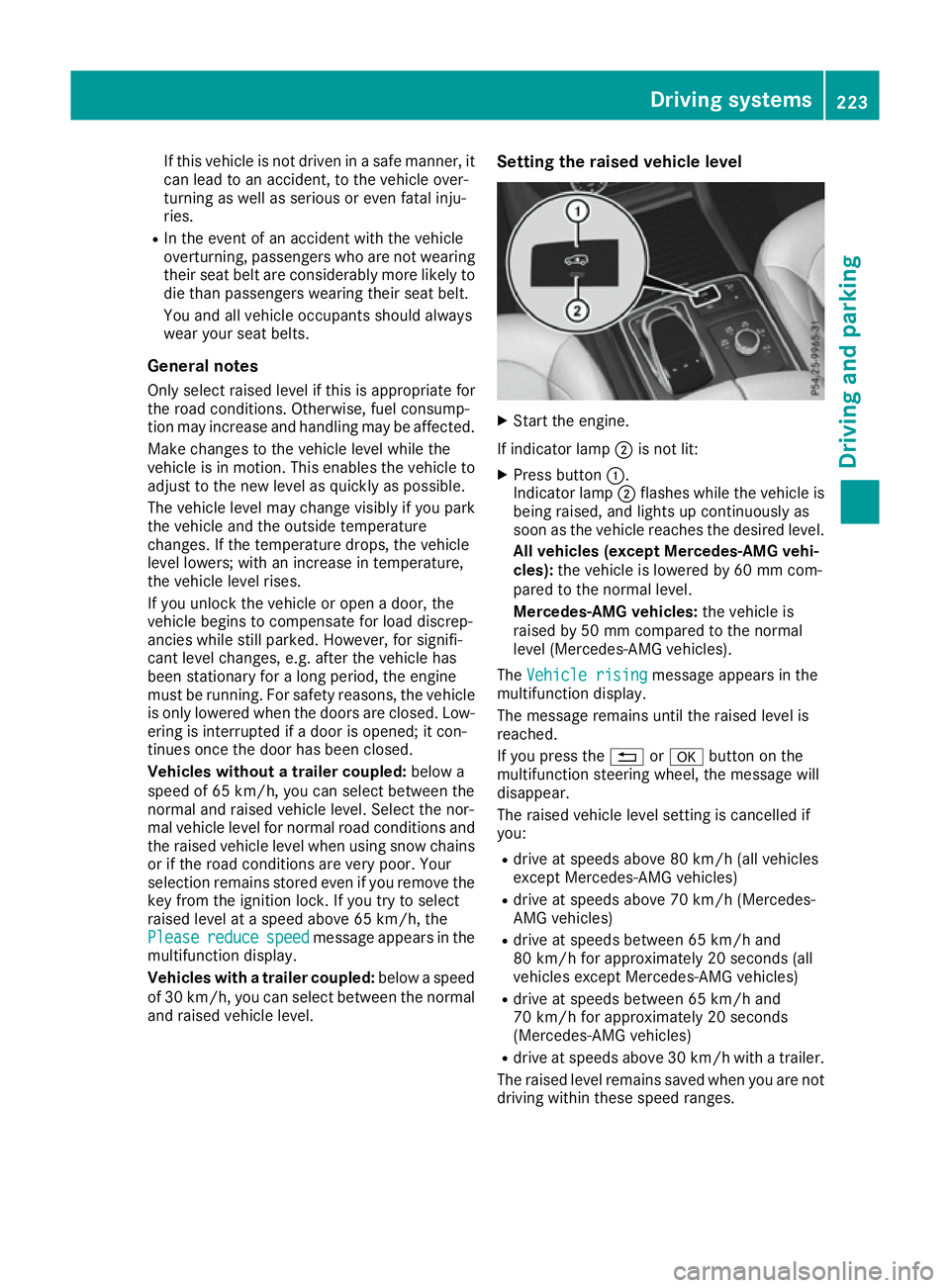
If this vehicle is not driven in a safe manner, it
can lead to an accident, to the vehicle over-
turning as well as serious or even fatal inju-
ries.
R In the event of an accident with the vehicle
overturning, passengers who are not wearing
their seat belt are considerably more likely to die than passengers wearing their seat belt.
You and all vehicle occupants should always
wear your seat belts.
General notes
Only select raised level if this is appropriate for
the road conditions. Otherwise, fuel consump-
tion may increase and handling may be affected.
Make changes to the vehicle level while the
vehicle is in motion. This enables the vehicle to
adjust to the new level as quickly as possible.
The vehicle level may change visibly if you park
the vehicle and the outside temperature
changes. If the temperature drops, the vehicle
level lowers; with an increase in temperature,
the vehicle level rises.
If you unlock the vehicle or open a door, the
vehicle begins to compensate for load discrep-
ancies while still parked. However, for signifi-
cant level changes, e.g. after the vehicle has
been stationary for a long period, the engine
must be running. For safety reasons, the vehicle is only lowered when the doors are closed. Low-
ering is interrupted if a door is opened; it con-
tinues once the door has been closed.
Vehicles without a trailer coupled: below a
speed of 65 km/h, you can select between the
normal and raised vehicle level. Select the nor-
mal vehicle level for normal road conditions and
the raised vehicle level when using snow chains or if the road conditions are very poor. Your
selection remains stored even if you remove the
key from the ignition lock. If you try to select
raised level at a speed above 65 km/h, the
Please
Please reduce reducespeed
speedmessage appears in the
multifunction display.
Vehicles with a trailer coupled: below a speed
of 30 km/h, you can select between the normal
and raised vehicle level. Setting the raised vehicle level X
Start the engine.
If indicator lamp ;is not lit:
X Press button :.
Indicator lamp ;flashes while the vehicle is
being raised, and lights up continuously as
soon as the vehicle reaches the desired level.
All vehicles (except Mercedes-AMG vehi-
cles): the vehicle is lowered by 60 mm com-
pared to the normal level.
Mercedes-AMG vehicles: the vehicle is
raised by 50 mm compared to the normal
level (Mercedes-AMG vehicles).
The Vehicle rising Vehicle rising message appears in the
multifunction display.
The message remains until the raised level is
reached.
If you press the %ora button on the
multifunction steering wheel, the message will
disappear.
The raised vehicle level setting is cancelled if
you:
R drive at speeds above 80 km/h (all vehicles
except Mercedes-AMG vehicles)
R drive at speeds above 70 km/h (Mercedes-
AMG vehicles)
R drive at speeds between 65 km/h and
80 km/h for approximately 20 seconds (all
vehicles except Mercedes-AMG vehicles)
R drive at speeds between 65 km/h and
70 km/h for approximately 20 seconds
(Mercedes-AMG vehicles)
R drive at speeds above 30 km/h with a trailer.
The raised level remains saved when you are not driving within these speed ranges. Driving systems
223Driving and parking Z
Page 232 of 453
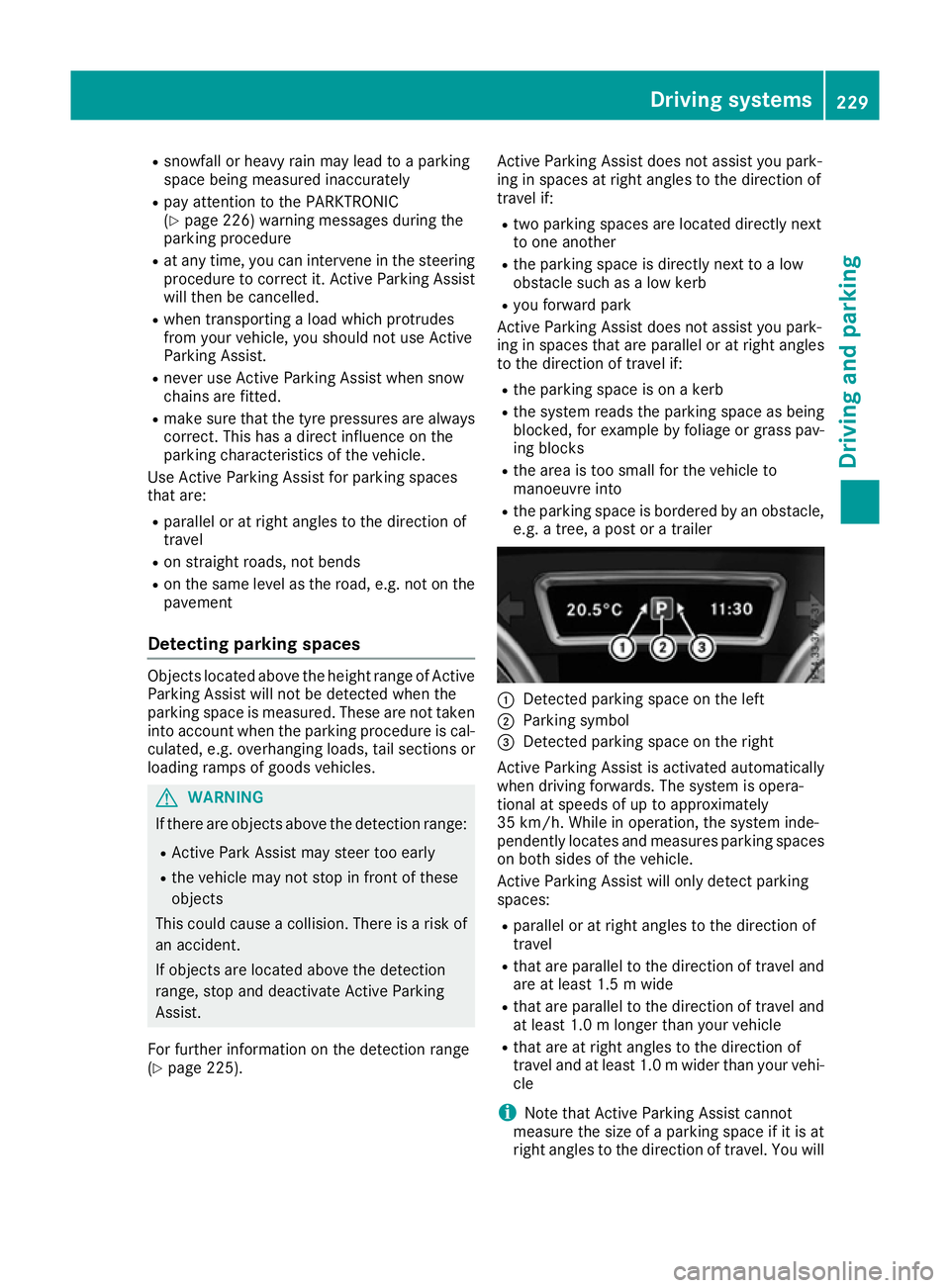
R
snowfall or heavy rain may lead to a parking
space being measured inaccurately
R pay attention to the PARKTRONIC
(Y page 226) warning messages during the
parking procedure
R at any time, you can intervene in the steering
procedure to correct it. Active Parking Assist will then be cancelled.
R when transporting a load which protrudes
from your vehicle, you should not use Active
Parking Assist.
R never use Active Parking Assist when snow
chains are fitted.
R make sure that the tyre pressures are always
correct. This has a direct influence on the
parking characteristics of the vehicle.
Use Active Parking Assist for parking spaces
that are:
R parallel or at right angles to the direction of
travel
R on straight roads, not bends
R on the same level as the road, e.g. not on the
pavement
Detecting parking spaces Objects located above the height range of Active
Parking Assist will not be detected when the
parking space is measured. These are not taken into account when the parking procedure is cal-culated, e.g. overhanging loads, tail sections or
loading ramps of goods vehicles. G
WARNING
If there are objects above the detection range:
R Active Park Assist may steer too early
R the vehicle may not stop in front of these
objects
This could cause a collision. There is a risk of
an accident.
If objects are located above the detection
range, stop and deactivate Active Parking
Assist.
For further information on the detection range
(Y page 225). Active Parking Assist does not assist you park-
ing in spaces at right angles to the direction of
travel if:
R two parking spaces are located directly next
to one another
R the parking space is directly next to a low
obstacle such as a low kerb
R you forward park
Active Parking Assist does not assist you park-
ing in spaces that are parallel or at right angles
to the direction of travel if:
R the parking space is on a kerb
R the system reads the parking space as being
blocked, for example by foliage or grass pav-
ing blocks
R the area is too small for the vehicle to
manoeuvre into
R the parking space is bordered by an obstacle,
e.g. a tree, a post or a trailer :
Detected parking space on the left
; Parking symbol
= Detected parking space on the right
Active Parking Assist is activated automatically
when driving forwards. The system is opera-
tional at speeds of up to approximately
35 km/h. While in operation, the system inde-
pendently locates and measures parking spaces on both sides of the vehicle.
Active Parking Assist will only detect parking
spaces:
R parallel or at right angles to the direction of
travel
R that are parallel to the direction of travel and
are at least 1.5 m wide
R that are parallel to the direction of travel and
at least 1.0 m longer than your vehicle
R that are at right angles to the direction of
travel and at least 1.0 mwider than your vehi-
cle
i Note that Active Parking Assist cannot
measure the size of a parking space if it is at
right angles to the direction of travel. You will Driving systems
229Driving and parking Z